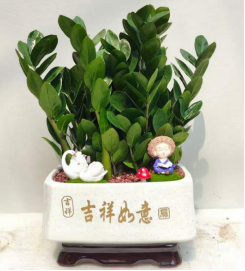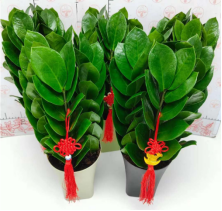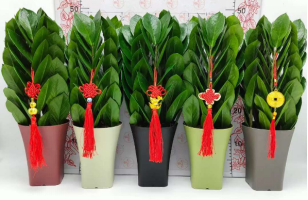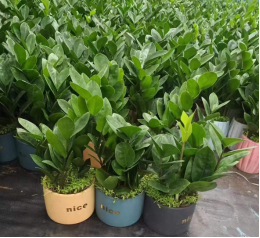学名:Zamioculcas zamiifolia
一般的な名前ZZプラント
植物の種類常緑樹
属ザミオカルカス属
家族サトイモ科
ZZ工場
ZZ植物(Zamioculcas zamiifolia)は、アオイ科に属する多年草である。アフリカ東部、特にケニアとタンザニアの地域が原産である。19世紀後半に初めて発見され、世界の他の地域で観葉植物として導入された。ZZプラントは、その魅力的な外観、回復力、メンテナンスの必要性の低さで評価されている人気の室内植物です。肉厚で多肉植物のような茎は直立し、高さは2~3フィート(60~90cm)に達します。
ZZの生長速度は遅いか中程度。地下の根茎から新しい茎を出しながら、直立し、塊状に、あるいは広がりながら生長するのが一般的です。時間が経つにつれて、密生してふさふさした外観になることもあります。成長が遅いので、頻繁に植え替えや剪定をする必要はありません。
ZZプラントの青々とした光沢のある葉は、どんな室内環境にもエレガントでトロピカルな魅力を加えます。家庭やオフィス、公共スペースの観葉植物としてよく使われます。中国の風水では、ZZは置かれた空間にポジティブなエネルギー、繁栄、幸運をもたらすと信じられています。家庭やオフィスの富やキャリアに関連したエリアを強化するために推奨されることが多い。

ZZは、光沢のある濃い緑色の葉が特徴で、蝋のように滑らかである。葉は数対の小葉からなり、羽のような、あるいは羽状になっている。直立性に生長し、根茎性で水を蓄えるため、乾燥にも耐えることができる。ZZの葉は最も特徴的なもののひとつである。葉は羽状複葉で、中央の茎に沿って複数対の小葉が並んでいる。葉の形は楕円形で、蝋のような光沢がある。各小葉は長さ2~6インチ(5~15センチ)、幅1~3インチ(2.5~7.5センチ)ほどに成長する。葉の色は深みのある豊かな緑色で、株全体の魅力を高めています。
ZZプラントの葉は、その耐久性と回復力で知られています。成長速度が緩やかなので、すぐにスペースが手狭になることはありません。この成長速度の遅さが、手入れの少ない観葉植物として適している理由です。葉は丈夫で、多少の乱暴な扱いやブラッシングにも傷むことなく耐えることができる。この性質は、ペットや子供のいる家庭に適している。ZZの生育は全体的にコンパクトで、茂り気味です。成木になると、地下の根茎から茎が伸びて、塊状や広がり状になる傾向があります。このような生長パターンにより、豊かで青々とした外観になります。

全体的に、ZZプラントの濃い緑色の光沢のある葉と直立する生育習性は、どんな家庭やオフィスにも視覚的に魅力的なアクセントを加えます。ユニークな葉と建築的なフォルムは、インテリア空間にエレガンスとトロピカルな魅力を加えます。スタンドアローンの標本として置いても、室内観葉植物のミックス・ディスプレイに組み込んでも、ZZは人目を引き、周囲に自然の美しさをもたらします。頻繁な剪定や植え替えを必要としない植物を好む方には、最適な選択肢となるでしょう。
空気清浄: 他の多くの室内植物と同様、フィカス・マイクロカルパは、特定の汚染物質や有害物質をろ過することで、室内の空気の質を改善するのに役立つ。
フィカス・マイクロカルパは、空気中の揮発性有機化合物(VOC)を効果的に除去することが分かっています。VOCは室内環境によく見られ、家具、カーペット、塗料、掃除用品など、様々な原因から排出される。フィカス・マイクロカルパの葉は、これらの有害化合物を吸収・分解するのに役立ちます。
フィカス・マイクロカルパの葉は、ほこり、花粉、その他のアレルゲンなどの空気中の粒子を捕捉して減少させることにより、天然のフィルターとして機能する。これは、特に呼吸器過敏症やアレルギー体質の人にとって、空気の質を改善するのに役立ちます。
他の植物と同様、フィカス・マイクロカルパも光合成のプロセスに参加し、二酸化炭素を吸収して酸素を放出します。この自然なプロセスは、周辺環境の酸素濃度を高め、室内の雰囲気をより新鮮で健康的なものにします。
空気浄化の効果を最大限に引き出すには、様々な種類の室内植物を置き、植物の密度と室内の適切な換気のバランスを保つことをお勧めする。さらに、化学物質の使用を最小限に抑え、定期的な清掃を行い、適切な換気を行うことが、室内の空気の質を改善するための全体的なアプローチとなる。フィカス・マイクロカルパのような植物を室内環境の一部として使用することは、これらの努力を補完し、より健康的な生活空間の実現に貢献します。
空気浄化の効果を最大限に引き出すには、様々な種類の室内植物を置き、植物の密度と室内の適切な換気のバランスを保つことをお勧めする。さらに、化学物質の使用を最小限に抑え、定期的な清掃を行い、適切な換気を行うことが、室内の空気の質を改善するための全体的なアプローチとなる。フィカス・マイクロカルパのような植物を室内環境の一部として使用することは、これらの努力を補完し、より健康的な生活空間の実現に貢献します。

軽い: ZZ植物(Zamioculcas zamiifolia)は、その空気浄化作用で知られている。ほとんどの植物は、光合成の際に二酸化炭素を吸収し、酸素を放出することで空気を浄化するが、ZZという植物は空気中の毒素を除去する能力も持っているのが特徴だ。
ZZプラントは、ベンゼン、トルエン、エチルベンゼン、キシレンなどの揮発性有機化合物(VOC)を空気中から効果的に除去することが示されている。これらの化合物は、塗料、溶剤、洗浄剤、合成繊維などの一般的な家庭用品に含まれている。さらに、ZZ植物の蝋質の葉は、空気中の粒子を捕捉するのに役立ち、室内の空気の質を向上させる。植物の中で最も強力な空気清浄機というわけではないが、より健康的な室内環境作りに貢献することは間違いない。
ZZプラントの最大の魅力は、その魅力的な外観とメンテナンスの必要性の低さにあるが、空気中の特定の有害物質をろ過する能力が、観葉植物としての総合的な価値を高めている。室内の空気の質が改善されると、人間の健康にいくつかの良い影響があります。空気がきれいになれば、呼吸器系の問題やアレルギーなど、室内の汚染物質に関連する健康問題のリスクを減らすことができる。ZZプラントのような植物を生活空間や仕事場に置くことで、より快適で健康的な環境を作り出すことができる。ZZ植物を含む様々な室内植物を取り入れることは、換気を良くし、化学製品の使用を最小限に抑えるなど、空気の質を改善するための他の戦略を補完することができる。
水だ: ZZプラント(Zamioculcas zamiifolia)は、乾燥に強いことで知られており、水やりに関しては比較的手入れが簡単な植物です。ZZプラントは、水やりの間、少し乾いている状態を好みます。水やりの前に、土の中に指を1インチ(2.5cm)ほど入れて、土の水分レベルをチェックします。その深さで乾いていると感じたら、水やりのタイミングです。水をやりすぎたり、土が常に湿っている状態は、根腐れなどの原因になるので避けましょう。

ピースリリーに水やりをするときは、鉢底から水が抜けるまで土を十分に含ませます。こうすることで、根球全体に水分が行き渡ります。水やりの後、受け皿やトレイに溜まった水は捨て、植物が水の中に放置されるのを防ぎます。ピースリリーが水不足になると、葉が垂れ下がったりしおれたりすることがありますが、水やりをすればすぐに回復します。長期間の水不足は長期的なダメージにつながるので、過度に乾燥させないことが大切です。水のやりすぎは、根腐れなどを引き起こし、ピースリリーにとって有害です。葉が黄色くなる、土が湿っているのにしおれる、土から悪臭がする、などが過湿のサインです。水やりのタイミングは、このような目で見て判断するようにしましょう。
水やりの頻度は、温度、湿度、光条件などさまざまな要因に左右されます。暖かい季節や明るい場所に植えた場合は、水やりの回数を増やすことができます。一方、涼しい季節や日照時間が短い場合は、水やりの回数を減らすことができます。株の様子を観察しながら、水やりのスケジュールを調整してください。ZZの葉が黄色くなったり、垂れ始めたりしたら、それは水のやりすぎのサインかもしれません。一方、葉がしわしわになったり、葉先が茶色くなったりした場合は、水不足の可能性があります。水やりのタイミングは、目視で確認しながら調整しましょう。
ZZに必要な水やりは、鉢の大きさ、用土の種類、環境条件などによって異なります。しかし、ZZは水をやりすぎるよりも、水不足にしたほうがよいでしょう。ZZは乾燥に強い植物なので、過湿よりも水やりの方が耐水性があります。土壌の水分に注意し、それに応じて水やりのスケジュールを調整することで、ZZプラントを健康で生育のよい状態に保つことができます。
温度だ: ZZプラント(Zamioculcas zamiifolia)は、東アフリカ原産の熱帯植物です。一般的に室内環境に適しており、様々な温度に耐えることができる。ZZプラントは、平均から暖かい温度で生育する。理想的には18℃から26℃を好みます。12℃の低温にも耐えることができますが、長時間の低温にさらされると、ダメージを受けたり、成長が遅くなったりすることがあります。ZZ は、12℃以下の場所に長期間置かないようにしましょう。
ZZは温度変化にある程度対応できますが、一般的には安定した環境を好みます。冬場のエアコンからの隙間風や窓からの冷気など、急激な温度変化にさらさないようにしましょう。急激な温度変化は株にストレスを与え、生育に悪い影響を与えます。高温(32℃以上)になると、葉が巻いたり、変色したり、葉焼けを起こすこともあります。日中の暑い時間帯は、明るく間接光の当たる場所に置くか、フィルターを通した光を当てるなどして、強い日差しからZZを守りましょう。
春から夏にかけての暖かい時期は、ZZの生育が活発になります。そのため、水やりの頻度がやや多くなります。一方、気温が低く、日照時間が短くなる冬の間は、生育が緩慢になったり、休眠期に入ることもあるので、株の周囲に湿度を与えたり、ラジエーターや暖房の吹き出し口など、直接熱源が当たらない場所に置くとよいでしょう。
全体的に、推奨される範囲内で安定した温度を維持することが、ZZ 鉢の健康と活力の確保につながります。極端な温度変化や長時間の低温にさらさないようにしましょう。
土壌だ: ZZプラント(Zamioculcas zamiifolia)は、余分な水分が流れ出しやすい、水はけの良い土壌で生育します。ZZプラントにとって最も重要な土壌の特徴は、水はけが良いことです。根腐れなどの原因になるので、余分な水分は与えないようにします。水はけのよい室内用培養土を選ぶか、市販の培養土にパーライトやバーミキュライト、粗目の砂、軽石などを加えて水はけをよくしましょう。ピートモス、コココイア、堆肥など、室内植物用に特別に調合された、軽くて通気性の良い鉢底ミックスを選ぶと、保湿性を高め、必要な栄養素を供給することができます。


ZZは、土壌のpHに過敏に反応することはなく、幅広いpHレベルに耐えることができる。pH6.0から7.5の弱酸性から弱アルカリ性の土壌が一般的に適しています。市販の培養土のほとんどは、この範囲内で配合されています。pHテスターを使って土の酸性度をチェックし、必要であれば調整することもできます。
ZZは、頻繁に植え替える必要はなく、やや根詰まりした状態を好みます。植え替えは、1~2年に1回、または現在の容器が大きくなったときに行います。植え替えの際は、少し大きめの鉢を使い、水はけのよい新しい用土を使います。土の水分レベルを観察し、それに応じて水やりを調節します。水はけのよい用土を使用し、適切な水やりを行うことで、ZZを健康で長持ちさせることができます。
伝播: ZZ植物(Zamioculcas zamiifolia)は、株分け、葉挿し、根茎挿しなど、さまざまな方法で繁殖させることができる。
ディビジョン この方法では、根茎と根をそれぞれ細かく分けることができます。株分けは、ZZを鉢から丁寧に取り出し、根茎を清潔な鋭利なナイフや鋏で、ひとつひとつの塊にそっと切り分けます。各分割株には、健全な根茎と数枚の葉があることを確認します。株分けした株は、水はけのよい土で別の鉢に植え、適切な手入れをする。
葉の挿し木: ZZ植物は葉挿しで繁殖させることができるが、この方法は株分けに比べて難しく、時間もかかる。健康な葉を選び、葉の一部と根茎の一部がくっつくように切り分けます。挿し穂を鉢に植え、水はけのよい用土を混ぜて、少し湿らせておく。時間が経つと、根茎の部分から新しい芽が出てくるはずです。
根茎の挿し木: この方法では、ZZ植物の太い地下茎である根茎を挿し木する。健康な根茎を選び、清潔な鋭利なナイフか鋏で切り分け、各節に少なくとも1つの芽か成長点があるようにする。切り取った根茎を、水はけのよい土を入れた鉢に、部分的に埋めるように植える。土は少し湿らせ、挿し穂が新しい株に成長するよう適切な手入れをする。
増殖には時間がかかり、成功率も方法によって異なります。ZZは一般的に生育が遅いので、増殖した株が定着し、生長するまでには数ヶ月からそれ以上かかることがあります。どのような方法で増殖させるにしても、適切な照明、適切な水やり、適切な温度範囲など、増殖させた植物に適切な条件を与えることが重要です。ZZの増殖には、忍耐と一貫したケアが重要です。